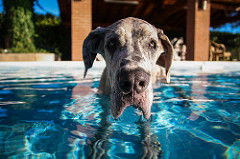
Hip dysplasia is one of the most dreaded diagnoses one can hear as a dog owner. Recently, the prevalence of hip dysplasia seems to have increased; yet the number of solutions remains the same. When it comes to this disease, there is little pet owners are offered. Well, it’s time for that to change. Hip dysplasia does not have to be the sentence of doom it once was, and can be managed in both an affordable and non-invasive way more often than not.
For those unfamiliar with the disease, it’s probably because you tend to have cats or smaller dogs. Hip dysplasia is a disease found predominantly in large breed dogs, such as German shepherds, Dobermans, Mastiffs, Great danes, Rottweilers, and Labradors. Now don’t think just because you don’t have a large breed dog that your pet is exempt. It can also occur in medium sized dogs, though not as commonplace, and very rarely will a small breed dog be born with hip dysplasia. There has been speculation lately that hip dysplasia is becoming more common in certain breeds due to bad breeding, inbreeding, and nutritional deficits. If this were the case, one would suspect selective breeding would be a great way to help eliminate the problem.
What Is Hip Dysplasia?

Hip dysplasia is a malformed hip joint. The hip is a ball and socket joint, the femur head being the ball and the acetabulum on the pelvis acting as the socket. The femur sits nicely within the acetabulum and is surrounded by an army of ligaments, muscles, and connective tissue. In a dysplastic dog, the femur will actually subluxate, or move out of normal position, from the acetabulum often due to ligament laxity. As the two joint surfaces separate, the ligaments begin to lose elasticity, the bones begin to develop abnormal wear patterns, and the overall structure of the joint will deteriorate. With abnormal structure in the joint, there will then be abnormal pressure and weight bearing. When abnormal pressure is placed on a joint, the body will counteract by developing more bone to support this pressure, also known as arthritis. Dysplastic dogs tend to develop arthritis very early in life and it continues to worsen as they age. Dysplasia can be in one, or both hips, it truly depends on the genetics and the makeup of the animal. Hip dysplasia is most commonly diagnosed using radiographs. Multiple sets may need to be taken to monitor the progress of the disease.
What Are The Symptoms?
Dogs with hip dysplasia may begin showing symptoms as early as puppyhood or remain asymptomatic until their later years. Earliest symptoms include:
- Gait changes
- Limping
- Pain, especially after exercise
- Exhaustion and lethargy
- Inability to climb up and down stairs
- Muscle atrophy
- Bunny hopping gait
- Stiffness in the hind limb
Some dogs will do better with exercise than others, while some may have trouble with the simplest of tasks. This is entirely dependent on the dog, and will vary from case to case.

How Does A Dog Get Hip Dysplasia?
Research indicates that hip dysplasia is in fact a genetic disease. Dogs do not just wake up one day with hip dysplasia, nor do they come home from doggy day care with it, it is not contagious nor can it be prevented. A dog that has a parent with hip dysplasia will effectively be a carrier for the disease even if he or she does not display symptoms. A dog with two parents both with hip dysplasia is highly likely to be symptomatic. A dog coming from a line with no history of hip dysplasia whatsoever has a very low chance of having the disease, however, one cannot be certain that no dog within the line wasn’t a carrier and asymptomatic.
Another train of thought comes from a nutritional aspect. It has been hypothesized that dogs with weight issues have a higher tendency to develop dysplasia. Rapid growth during puppyhood is also thought to possibly contribute. Lastly, a lack in balance of certain vitamins in minerals during development could also be a factor. 
What About Exercise?
Some veterinarians are of the school of thought that too much exercise at a young age can kick-start hip dysplasia. Others claim, however, that getting a good deal of exercise when dogs are young will help maintain a healthy weight and a balanced muscle mass. Dogs with above average muscle tone and strength are less likely to develop dysplasia in the first place compared to dogs that are weak in the hind.
Prevention & Quality Of Life Care
We often get asked whether dogs with hip dysplasia are candidates for chiropractic care, and the answer is a big YES. Animals with subluxations in any joint are going to have to compensate for that abnormality in some way. Usually, the joints above and below the affected one are the victims. For instance, those with hip dysplasia tend to have lower back and knee issues simply because these two joints are compensating for the bad hip joint. Through chiropractic care, all structural shifts within the body are addressed and thus allow for a more stable spine. Physical therapy, massage, and hydrotherapy are also great alternative therapies for dogs diagnosed with hip dysplasia. Each methodology addresses another part of the body and all work wonderfully together. Supplementation to be certain your animal is getting the proper nutrition for growth and development is essential. Glucosamine, chondroitin, omega-3 fatty acids, and MSM are all highly recommended. Please note that hip dysplasia itself, once it has occurred, will never be “cured”, however, it can be managed.

There are multiple surgical procedures currently advised in hip dysplasia cases. They often will cut through the ligaments and musculature to reposition the femoral head, or break the bone itself to reposition or reshape it. Another procedure will remove the femoral head and neck entirely and reconfigure the soft tissue around the joint to act as the support. Finally, there is such thing as a total hip replacement for dogs, where the defective joint is replaced with a prosthetic. Medical management can also include injectables, such as Adequan, as well as prolonged steroid and anti-inflammatory usage.
If you are uncertain whether or not your pup has hip dysplasia, your best bet is to visit your veterinarian. Look for any outward symptoms and consider the breeds found predominantly in your dog. If you suspect something may not be right, radiographs often offer a definitive diagnosis. Once your pup is diagnosed with the disease, realize that you have several options from that point both conventionally and alternatively. Keep an open mind and a positive outlook, hip dysplasia can absolutely be managed and many dogs live long and happy lives with little discomfort or problem from the disease.
Sources:
http://www.peteducation.com/article.cfm?c=2+2084&aid=444
http://www.merckvetmanual.com/pethealth/dog_disorders_and_diseases/bone_joint_and_muscle_disorders_of_dogs/joint_disorders_in_dogs.html#v3205307
Photo Credit:
To the West via photopin (license)
You talkin’ to me? via photopin (license)
Pluto my English mastiff puppy of … via photopin (license)
I Exposición Monográfica Club Rottweiler de España – Santa Brigida – Gran Canaria. via photopin (license)
????… via photopin (license)
Bloem 05 May 2015 via photopin (license)

